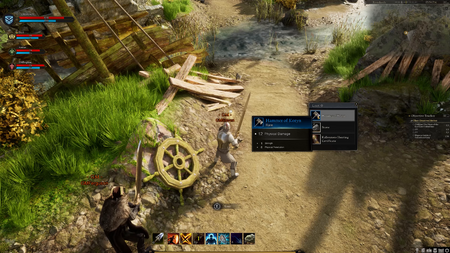Gerenciador mundial
O Gerenciador Mundial é um algorítmo em Ashes of Creation responsável por controlar elementos dinâmicos do mundo. Ele age como um sistema tanto limitador como incentivador para diversas atividades, com o objetivo de garantir que certos parâmetros estejam dentro de limites aceitáveis.[1]
- Preços de certificados de caça.[2]
- Um mapa de atividade da experiência recebida para ser usada na evolução de base.[2]
- Movimentação de recursos e bens entre regiões para incentivar recompensas de missões nas bases.[2]
Por exemplo, se você sabe que o ferro está sendo usado como um recurso primário na fabricação de certos itens, isso pode aumentar o preço da prata ou do mithril; isso pode incentivar o mercado a se corrigir um pouco. A ideia é oferecer pequenos incentivos para ajudar a aliviar a demanda e também aumentar a oferta que pode não estar presente nos sistemas econômicos.[2] – Steven Sharif
Evolução de Base
Bases avançam ao coletar experiência das ações de jogadores próximos. À medida que os jogadores participam de conteúdos dentro da Zona de Influência de uma Base (a área ao seu redor), eles contribuem aquela experiência para o desenvolvimento da Base. A experiência dada a uma Base pode ser modificada com base em certos Eventos e Conquistas. Quando uma Base alcança a experiência necessária, passa pelo processo de avançar para o próximo estágio. Existem algumas exceções em que uma Base não pode avançar mesmo que tenha a experiência necessária - comumente, uma Base não pode avançar se é Vassala de outra Base e avançaria para o mesmo estágio da Base Dominante.[3] – Margaret Krohn
Aa atividades de jogadores Cidadãos and não-cidadãos (missões, coleta, raids, etc.) dentro da ZOI de uma base conta para a evolução daquela base específica (progressão).[4] Bases possuem sete (7) estágios de evolução, com barreiras de experiência para cada estágio. Quando uma Base alcança a experiência necessária em seu estágio atual, ela evolui para o próximo.[5]
| Estágio de base.[4] | Nome alternativo.[6] | Tempo para evoluir.[4] | Residência de jogadores.[7] | |
|---|---|---|---|---|
| 0. | Região Selvagem | - | ||
| 1. | Expedição | Encruzilhada | Algumas horas | - |
| 2. | Acampamento | Campo | Muitas horas | - |
| 3. | Vilarejo | Vila | Alguns dias | Casas de pequeno porte |
| 4. | Município | - | Muitos dias | Casas de médio porte |
| 5. | Cidade | - | Algumas semanas | Casas de grande porte |
| 6. | Metrópole | Metro | Muitas semanas | Mansões |
A Área de Desenvolvimento de uma Base é onde a civilização apareçerpa à medida que a Base evolui. Com o aumento do Estágio da Base, diferentes prédios, PNJs, e serviços ficarão disponíveis na Área de Desenvolvimento. Quanto maior o Estágio da Base, mais complexa e povoada a Área de Desenvolvimento se torna. Áreas de Desenvolvimento também irão variar dependendo do Tipo de Base - Mercantil, Militar, Científica, ou Divina; entraremos em detalhes sobre cada um desses Tipos em posts futuros nessa série.[3] – Margaret Krohn
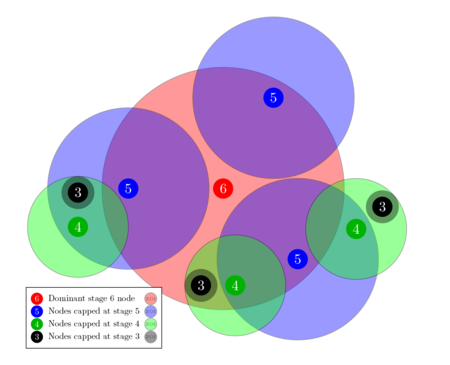
A partir do Estágio de Base 3, quando uma Base evoluir, ela dominará as Bases próximas, transformando-as em Vassalas. Bases Vassalas pertencem à Base Dominante precisam estar pelo menos um Estágio abaixo da mesma. Isso significa que Bases Vassalas não podem crescer até que sua Base Dominante evolua para o próximo estágio. Bases Vassalas entregam qualquer excesso de experiência à Base Dominante, e podem ter suas próprias Vassalas, desde que estejam dentro da Zona de Influência da Base Dominante. Estão sujeitas ao governo, alianças, guerras, impostos, e comércio da Base Dominante, e podem receber ajuda federal da mesma. Uma Base Vassala não pode declarar guerra contra sua Base Dominante ou suas Vassalas. Cidadãos de Vassalas estão sujeitos às situações diplomáticas de sua Base Dominante.[5] – Margaret Krohn
A evolução de uma base libera seu conteúdo único, mas vem com a desvantagem de travar o avanço de um número cada vez maior de bases vizinhas.[9]
- Bases avançam para o primeiro estágio rapidamente. Isso disponibiliza serviços de PNJs como vendedores e armazenamento de itens.[10]
- Quanto mais evoluída uma base, maior sua ZOI.[11]
- Bases menos evoluídas (chamadas de bases vassalas) que se encontram dentro da ZOI de uma base mais evoluída ainda podem ganhar XP, mas precisam ficar em um estágio de evolução menor que o da base dominante.[8]
- O sistema de vassalos começa quando uma base chega no estágio 3 (vilarejo), mas bases vizinhas em estágios abaixo de 3 também bloqueiam o crescimento de seus vizinhos imediatos.[12]
- Devido à maneira que o algorítimo de progressão calcula a expansão territorial (ZOI) durante a evolução de base, existe a pequena possibilidade de duas bases no mesmo estágio ficarem próximas uma da outra.[13]
- O algorítimo de expansão territorial leva em conta a costa mais próxima, bases vizinhas, e a atividade de jogadores nas áreas próximas ao longo das últimas semanas ou mês.[14]
Normalmente o algorítmo que é aplicado à expansão territorial de uma base previne que bases significantes fiquem próximas...Pode acontecer uma incrível coincidência onde toda a progressão algorítmica de território faça com que essas bases fiquem próximas pois existem certos requerimentos necessários para a dominação de uma base vassala; e é possível que duas bases nunca dominariam a outra como vassala e acabem ficando próximas e crescendo em direções opostas: fica parecendo Um Conto de Duas Cidades.[13] – Steven Sharif
- Uma base não recebe XP de bases dentro de sua ZOI até que eles tenham chegado ao limite de XP.[8]
- Jogadores são movidos para um local seguro se colidirem com estruturas que aparecem durante a evolução de base.[15]
- Cidadãos de uma base podem contribuir para o avanço de outras bases.[16]
- A porcentagem exata de experiência de evolução ao obter itens ou matar monstros não será conhecida explicitamente para evitar que os jogadores "otimizem" o sistema.[17]
Pessoas diferentes tem recursos diferentes investidos na progressão de uma base, e seria meio 'meta' se você soubesse exatamente o que é necessário para evoluir, pois isso desincentivaria jogadores de participarem.[17] – Steven Sharif
Nodes vassalos
Nodes acima do estágio 3 (Vilarejo) dominam bases próximas, convertendo-as em bases vassalas.[5][12]
- Bases vassalas são obrigadas a ficar um estágio de base abaixo da base dominante.[5]
- Bases vizinhas abaixo do estágio 3 também podem impedir o crescimento de seus vizinhos imediatos. Isso será testado no Alfa 1.[12]
- Bases vassalas priorizam seu próprio déficit quando ganham experiência (ver Atrofia de base). Apenas então aplica experiência em excesso à base dominante.[3]
- Se uma base dominante evolui, a base vassala passa a poder evoluir.[5]
- Bases vassalas dão qualquer excesso de experiência à base dominante e podem ter suas próprias vassalas, desde que essas bases estejam dentro da zone of influence|zona de influência da base dominante.[5]
- Se uma base vassala está no limite de experiência e tem suas próprias vassalas, qualquer experiência recebida tanto dela quanto das vassalas será aplicada ao seu próprio déficit e, somente então, à base dominante.[3]
- Vassalas estão sujeitas ao governo, alianças, guerras, impostos, e comércio de sua base dominante, e podem receber ajuda federam da mesma.[5]
- Bases vassalas não podem declarar guerra contra sua base dominante ou qualquer vassala da mesma.[5]
- Cidadãos das vassalas são regidos pelos estados diplomáticos da base dominante.[5]
Se uma Base é Vassala e está impedida de evoluir, ela vai aplicar qualquer experiência ganha ao seu próprio déficit (ver seção sobre Atrofia), e então aplica experiência em excesso à Base Dominante. Se a Base Dominante evolui e a Vassala é liberada para crescer, ela perde o limite de experiência (até voltar a ficar um estágio abaixo da Base Dominante). Se uma Base está no limite e tanto é vassala como possui vassalas, qualquer experiência ganha de si própria ou das vassalas é primeiro aplicada ao seu déficit e então à Base Dominante.[3] – Margaret Krohn
Loot tables
- Mobs drop glint, Itens, and crafting materials in preference to gold.[19][20]
- Glint is not bound to a specific region and can be also dropped by players on death as stolen glint, based on applicable death penalties.[21][22][23][24][19][25]
- The rarity of glint increases with the mob's level.[26]
- Loot tables are disabled for player controlled monsters.[27]
- There is a small RNG chance of looting rare and legendary items or crafting materials from mobs based on the level, status and type of mob. This also applies to harvesting resources with a gathering profession.[28]
- Experience debt decreases the drop rate percentages from monsters.[29]
- Loot (loot tables) from world bosses or dungeon bosses has a small RNG chance of dropping gear (completed items).[30][31]
- There is a much higher chance that materials and unique recipes are dropped that can be used to craft items of equitable value.[30][32][33]
- Legendary equipment is only dropped by Legendary world bosses.[34]
- Loot tables will likely not be affected by weather conditions.[36] This was previously listed as a possible effect.[37]
- There won't be specific loot drops for artisans.[38] Previously it was stated that master gatherers may have the ability to "spoil" a boss' loot.[39]
- Q: Can only one gathering artisan harvest resources from a single boss, or can multiple different artisans harvest different parts from a boss for different resources? For example, a lumberjack gets a special wood from Tumock's tree weapon, while a herbalist gathers the flowers from that same tree.
- A: We don't have the concept of harvesting from bosses. NPCs follow a reward table format, where those reward tables are global. They're not unique to particular players. So, once the NPC is vanquished, you have access to the loot container that is its corpse; and it has a static value of either materials or items that get dropped; and whatever the party loot settings are that you might be a part of, or if you're a solo player you will be able to recover those things.[38]
Population based scaling
The prices that NPCs sell items for will scale based on the economic activity on a server. Prices will rise to combat inflation and fall as a population diminishes.[40]
The node system allows the developers to scale the experience needed to level a node and the attrition that affects a node based on activity.[40]
Things that NPCs buy and sell scale based on the economic activity that exists on that server... As inflation rises, prices rise and everything ends up being equal, even though there might be a couple of extra zeros. So that can go up and it can also go down so as a population leaves, things become less expensive and players don't have to do as much to earn that. On the other side of things we look at the node system and the node system is set up in this really flexible way that allows us to scale the experience needed to level a node and the attrition that delevels a node to scale based on activity too. So it's just a matter of adjusting a couple of constants and that goes up and down and the server can watch it and change those on the fly as it needs to.[40] – Jeffrey Bard
Adaptive content
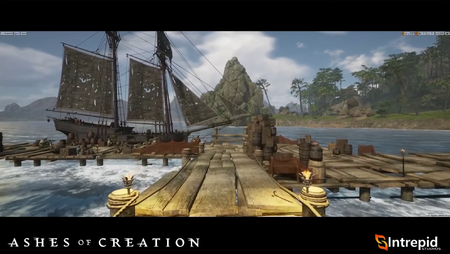
This is actually a dynamic POI. This one will evolve as players evolve the node that it's attached to. So this is its final state.[41] – Jeffrey Bard
New points of interest (such as dungeons, world bosses, and corrupted areas) spawn as nodes develop.[42][43] This content adapts to the node progression of the zone it is in.[41][44]
- Additional buildings will spawn.[41]
- Additional mobs will spawn.[41]
- Different antagonists/leaders with different story lines.[41][44]
- Populations will change.[44]
- Content difficulty will change.[44]
- The content may be different altogether.[44]
- Additional quest hooks.[41]
- Masmorras will be unlocked when certain nodes advance to certain stages.[45]
- Drop tables in areas and dungeons will be tied into the progression of certain areas.[45]
- POI events are events that relate to specific points-of-interest (POI).[48]
- The location of points of interest will be the same on each server, but some servers may have limited or no access to them.[49]
- Certain dungeons and other points of interest across the map will all be affected by the server’s node development. Some dungeons will only be unlocked if nodes are developed to certain stages. The storyline objectives for players inside dungeons will also be dependent on the story arc paths chosen through the node system. The drop tables in area and dungeons will also be tied into the progression of certain areas. For example, let’s say that the humans have developed a node in Region A, and a storyline has opened up that leads players to inspect the ruins (dungeon) of a nearby area. And let’s say that this node was developed in a scientific (crafting) zone… Well before the node developed, this dungeon was accessible… But now the dungeon has propagated new monster assets that include a drop table catering to a crafting emphasis because of the development of that academic node. And perhaps, a new boss appears in different rooms of the dungeon that includes different adventure quest starts, like a mysterious item with a storyline that can only be progressed if a node develops to the metropolis stage in a certain region, across the world. Our system is so vast, when it comes to interconnectivity and how the world reacts to the players.[45]
Raid strategies
Raids will have elements that can be pre-planned.[50]
Raids will also have dynamic elements that can change from session to session.[50]
- The types and numbers of bosses and mobs present in the raid and their skill repertoire.[50]
- Variables are manifested based on node progression.[50]
- The number of metropolis nodes developed.[50]
- The types of metropolis nodes developed.[50]
- One of the design elements that we're implementing into our raids is that the raid will not be exactly the same every single time. You're going to have variables that can't necessarily be pre-planned out for. You can pre-plan out for a lot of the raid like how many DPS do you need and healers and support; where the key position and all that stuff; but I think the compelling aspect of Ashes raiding will be the difficulty in achieving this content and having that content change from session to session as well. We want there to be variables that get manifested by what type of node got developed elsewhere. Is he going to have acolytes or cultists? What will the acolytes have skills [available] to them? What kit is the boss gonna have? What available skill repertoire will the boss be able to [wield]? ... A lot of those systems are influenced obviously by world development. So the raid takes into account at what stage has the world developed: Are there two metropolises now available in the world? Okay well let's activate this skill in this skill. Now you have five metropolises, well now all these skills have been activated. Are there are they all economic nodes? Are they all military nodes? That we can change things based on that stuff. And it really is a threat assessment from the environment against the players.[50]{{ndash|Steven Sharif}
PvE difficulty
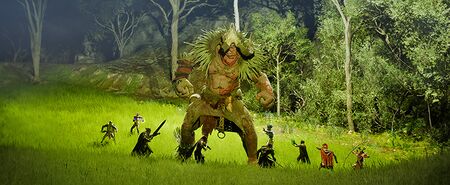
Raid bosses are aware of the number of combatants within an area in proximity to them and that awareness is part of an indicator to which behaviors they're going to utilize as part of their behavior tree. So as it's assessing the types of combatants that are facing it, the number of those combatants, the position of those combatants, the abilities and totals of those combatants, it weighs certain actions in its behavior tree and then it acts on those actions; and in the scenario where you're bringing overwhelming odds to a particular fight, that might weigh heavier the AoE options that the boss has access to, where they're utilizing a lot more AoE abilities during an engagement due to that overage of of players. So in that sense it's a bit adaptive. It's a bit dynamic based on the encounter scenario.[52] – Steven Sharif
The difficulty of PvE content, such as raids and dungeons will adapt based on the performance of the raid or group against previous bosses in that encounter.[53]
- Higher performance in earlier phases will increase the difficulty of subsequent phases of the encounter.[53]
- Certain AI behaviors might activate based on progress within an encounter.[52][54]
- Bosses and mobs will not auto-scale based on group size, but AI behaviors may dynamically adapt to the number and types of combatants in proximity to the encounter.[52][55]
- Both in Alpha-2 and when the game launches, there will be monsters whose technical level is above that of the cap; and the intent there is obviously again to provide some level of challenge that exceeds a comparable level challenge rating.{livestream|2023-11-30|1h53m50|V9F_AJl9ozY}} – Steven Sharif
- The higher the difficulty, the better the loot tables will be.[53]
- Q: How challenging will raid boss mechanics be given the given that players may need to simultaneously fight other players while also fighting the boss?
- A: It depends. The great thing about our encounter system is that it has a wide scalability from encounters that some might consider easy given their composition to encounters that some might consider impossible until they get their gear level to a certain stage. The level of interaction with other players is really predicated on the encounter itself. We may have some encounters that are in instances although the predominant portion of those will be in the open world, in which case they do have the potential being contested; and these encounters, especially the big ones that might land in contention, are giving some of the best-in-slot gear you can get in the game. So it's important that they are contested because it is a significant victory point; and one of our core pillars is risk versus reward: and the higher that risk the higher that reward should be. So those two things seem fitting and then in addition we do have the concept of winners and losers. Not everybody in Ashes of Creation is going to be a winner; and that sucks if you're not I guess, but there is opportunity for you to continue to excel and become one. But it gives much more meaning to an achievement when not everybody gets the achievement. That's our philosophy.[57] – Steven Sharif
- Q: So it's the sort of thing where it might be, we're going do a dungeon that's oops, all fire golems, so if everybody straps up with plate armor and fire resistance, you don't have to worry about the magic fire: you've got the fire resistance for. And when you start getting punched around, that's why everyone's come in with plate?
- A: The encounters design team presents a particular type of challenge rating- for those you're familiar with playing DnD or whatever, challenge rating gets informed by a few different vertical power levels, but then there's also the horizontal perspective: That is, what tools does your party have to address the challenge rating of the situation and some of the horizontal progression exists within how you kit your equipment slots. Some of those can be enhancements or stones, as you're discussing with fire resistance. Some of those are base stats that exist on a particular item, such as physical damage mitigation versus magical damage mitigation and what subtype of damage is incoming based on that. These are the ways that we emphasize that more rock-paper-scissors type of interaction with balance to where it's okay to have asymmetric imbalance if there are horizontal methods by which you achieve the challenge rating.[58] – Steven Sharif
Ver também
Referências
- ↑ Entrevista, 2020-07-19 (1:10:55).
- ↑ 2.0 2.1 2.2 2.3 Entrevista, 2020-07-19 (1:08:22).
- ↑ 3.0 3.1 3.2 3.3 3.4 Blog - Know Your Nodes - Advance and Destroy.
- ↑ 4.0 4.1 4.2 A reactive world - Nodes.
- ↑ 5.0 5.1 5.2 5.3 5.4 5.5 5.6 5.7 5.8 Blog - Know Your Nodes - The Basics.
- ↑ Transmissão ao vivo, 2018-12-12 (14:48).
- ↑ Entrevista, 2020-07-20 (3:45).
- ↑ 8.0 8.1 8.2 Transmissão ao vivo, 2017-10-16 (50:20).
- ↑ Vídeo, 2017-04-20 (0:02).
- ↑
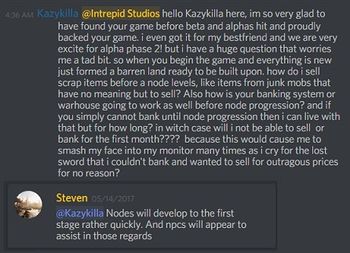
- ↑ Node series part II – the Metropolis.
- ↑ 12.0 12.1 12.2

- ↑ 13.0 13.1 Entrevista, 2020-07-08 (1:00:15).
- ↑ Entrevista, 2020-07-18 (10:04).
- ↑ Transmissão ao vivo, 2017-11-17 (55:27).
- ↑
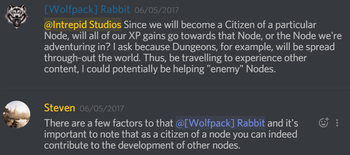
- ↑ 17.0 17.1 Transmissão ao vivo, 2017-05-26 (28:16).
- ↑ Vídeo, 2023-01-27 (16:44).
- ↑ 19.0 19.1 Entrevista, 2020-07-18 (27:11).
- ↑ Transmissão ao vivo, 2017-05-24 (44:14).
- ↑

- ↑ Entrevista, 2023-09-10 (53:47).
- ↑ Transmissão ao vivo, 2021-03-26 (1:07:33).
- ↑

- ↑ Podcast, 2017-05-05 (43:05).
- ↑

- ↑ Transmissão ao vivo, 2017-05-03 (35:25).
- ↑ Entrevista, 2020-07-18 (1:00:15).
- ↑ Ashes of Creation Forums - Former Lineage 2 PvP'er wanting to discuss PvP loopholes.
- ↑ 30.0 30.1 Entrevista, 2020-07-19 (8:43).
- ↑ February 8, 2019 - Questions and Answers.
- ↑ Entrevista, 2020-07-20 (21:57).
- ↑ Transmissão ao vivo, 2018-04-8 (PM) (55:49).
- ↑ 34.0 34.1 Transmissão ao vivo, 2020-07-25 (46:08).
- ↑ Transmissão ao vivo, 2020-12-22 (1:15:01).
- ↑ Transmissão ao vivo, 2022-05-27 (1:14:46).
- ↑ Vídeo, 2022-05-27 (2:21).
- ↑ 38.0 38.1 Transmissão ao vivo, 2024-02-29 (1:22:09).
- ↑ Podcast, 2018-08-04 (1:44:54).
- ↑ 40.0 40.1 40.2 Transmissão ao vivo, 2018-06-04 (39:15).
- ↑ 41.0 41.1 41.2 41.3 41.4 41.5 41.6 Transmissão ao vivo, 2021-03-26 (50:33).
- ↑ Transmissão ao vivo, 2021-03-26 (22:53).
- ↑ Transmissão ao vivo, 2017-11-17 (36:22).
- ↑ 44.0 44.1 44.2 44.3 44.4 Transmissão ao vivo, 2017-11-17 (18:29).
- ↑ 45.0 45.1 45.2 45.3 MMOGames interview, January 2017
- ↑

- ↑

- ↑ Transmissão ao vivo, 2022-04-29 (40:21).
- ↑
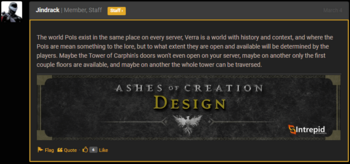
- ↑ 50.0 50.1 50.2 50.3 50.4 50.5 50.6 50.7 50.8 Podcast, 2018-07-09 (22:24).
- ↑ Newsletter - June 2023.
- ↑ 52.0 52.1 52.2 Transmissão ao vivo, 2023-01-27 (1:34:06).
- ↑ 53.0 53.1 53.2 Entrevista, 2020-07-19 (14:51).
- ↑ Entrevista, 2021-06-13 (22:20).
- ↑ Entrevista, 2020-07-19 (17:12).
- ↑ Transmissão ao vivo, 2023-11-30 (1:53:50).
- ↑ Transmissão ao vivo, 2022-05-27 (1:20:35).
- ↑ Entrevista, 2023-07-09 (1:40:41).
